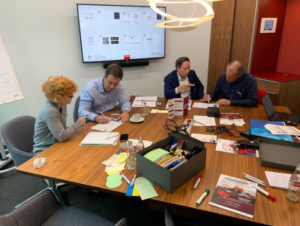Incremental innovation in silos not enough, says Dr. Catharina Bening, of the Group for Sustainability and Technology (SusTec) at Swiss university ETH Zurich – working with CEFLEX to increase common understanding and action towards a circular economy for flexible packaging.
Many companies and organisations associated with flexible packaging in Europe, recognise the need to transform the linear economy of take, make and dispose; and have taken leadership to address this challenge, by joining the CEFLEX to deliver a circular economy for flexible packaging.
Today, CEFLEX stakeholders represent a collective of over 150 companies, which in Europe alone employ more than 500,000 people at over five and a half thousand locations.
They are collaborating and working across the entire value chain to accelerate solutions in collection, sorting, packaging design, facilitating technologies and sustainable end markets – all underpinned and incited by an environmental and economic business case.
For Dr. Catharina Bening, of the Sus Tec Group at ETH, collaboration and alignment on key issues is critical to moving forward and achieving a circular economy:
“When you think about the shift to a circular economy – it is a paradigmatic shift. You can’t achieve it through incremental innovation at singular value chain steps, so you need the entire value chain to collaborate” she says.
“This is why I think CEFLEX is a wonderful example of trying to achieve a circular economy -because many stakeholders have lined up to make something happen that would not happen if each single company was trying to reach that goal.”
The CEFLEX initiative has set itself the ambitious ‘Mission Circular’ of enabling collection of all flexible packaging and recycle 80% of it into new valuable materials; becoming either new packaging or flowing back into the wider circular economy. To make it a reality, a 5-step roadmap to build a circular economy for flexible packaging has been endorsed by CEFLEX stakeholders, together with a set of actions needed by each part of the value chain to make it happen.
Impossible to achieve alone
Innovating and optimising as single companies, will not deliver the required shift to deliver them Dr. Bening suggests. Collaboration is key “to try and achieve something bigger, as an industry, because they can communicate, talk to each other” she says. Exchanging is vital to challenging existing assumptions Dr. Bening continues – which may be slowing the required innovation and mindset changes needed to move towards a circular economy.
“The mere fact that you have this communication platform is a big advantage in the competition of who reaches a circular economy solution; before it is too late from various perspectives”.
Understanding and alignment on critical issues
To support CEFLEX’s vision and help the entire value chain move forward as one, a report from ETH Zurich in collaboration with CEFLEX – and supported by the EIT Climate-KIC – examined the market and barriers. It combined market intelligence, analysis and interviews with stakeholders and additional external experts to clarify the most relevant barriers to a circular economy and table key issues to tackle.
A workshop with CEFLEX stakeholders in September 2019 further built on this – collecting and synthesising topics essential to realising the circular economy for flexible packaging that need alignment. The aim is to tackle each of them individually and to create considered and aligned positions on each topic so that these can guide transformation to a circular economy across the entire value chain.
The first dedicated workshop to an issue was held in late January 2020 and dedicated to building a common position on mono materials in flexible packaging. Marianne Kuhlmann from SusTec at ETH Zurich was a core part of the team moderating discussions of 25 participants from across the value chain.
“For each topic where there are diverging opinions, we first work together to reveal our differences and create a common understanding. And then we work with all the stakeholders to draft a common position which the majority of stakeholders can agree upon” she explains.
Clarity and action
After a full day of tough discussions, the entire group were able to agree on a CEFLEX position statement, ‘Accelerating the circular economy for flexible packaging – a recommendation for recyclable mono-materials’. It has been shared with stakeholders and the CEFLEX steering committee and will be made available to the wider industry as part of a coordinated release along with future positions on alignment issues.
“I think what the position papers do is make the vision and goal of CEFLEX actionable. Because a goal and vision can be broad, but stakeholders and the whole industry need some guidance on how to actually get there. And the position statements make it clear” continues Marianne Kuhlmann.
The recommendations in this first position paper on mono materials chimes with another major deliverable from CEFLEX – a set of guidelines on flexible packaging design.
‘Designing for a Circular Economy’, is a set of comprehensive guidelines to help anyone working in the flexible packaging value chain design recyclable packaging solutions. One of the main points of the guidelines is that flexible packaging should be designed to meet its core function, protecting goods and reducing the risk of product waste.
This combination of innovation and mindset change is critical to delivering the economic, environmental and social benefits of the circular economy. Corona Virus scenarios allowing, the next future alignment workshop will seek to achieve consensus on ‘Separate collection versus mixed waste collection and post sorting’ – with equally important progress expected on the road to Mission Circular.

